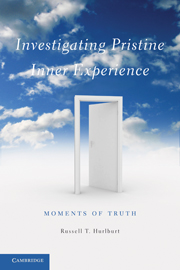Book contents
- Frontmatter
- Contents
- List of Figures and Tables
- Preface
- Acknowledgments
- 1 Moments of Truth
- 2 Fragmented Experience in Bulimia Nervosa
- 3 Apprehending Pristine Experience
- 4 Everyday Experience
- 5 Moments Are Essential
- 6 Experience in Tourette's Syndrome
- 7 The Moment (Not): Happy and Sad
- 8 Subjunctification
- 9 Before and After Experience? Adolescence and Old Age
- 10 Iteration Is Essential
- 11 Epistemological Q/A
- 12 A Consciousness Scientist as DES Subject
- 13 Pristine Experience (Not): Emotion and Schizophrenia
- 14 Multiple Autonomous Experience in a Virtuoso Musician
- 15 Unsymbolized Thinking
- 16 Sensory Awareness
- 17 The Radical Non-subjectivity of Pristine Experience
- 18 Diamonds versus Glass
- 19 Into the Floor: A Right-or-Wrong-Answer Natural Experiment
- 20 The Emergence of Salient Characteristics
- 21 Investigating Pristine Inner Experience
- Appendix: List of Constraints
- References
- Index
19 - Into the Floor: A Right-or-Wrong-Answer Natural Experiment
Published online by Cambridge University Press: 05 June 2012
- Frontmatter
- Contents
- List of Figures and Tables
- Preface
- Acknowledgments
- 1 Moments of Truth
- 2 Fragmented Experience in Bulimia Nervosa
- 3 Apprehending Pristine Experience
- 4 Everyday Experience
- 5 Moments Are Essential
- 6 Experience in Tourette's Syndrome
- 7 The Moment (Not): Happy and Sad
- 8 Subjunctification
- 9 Before and After Experience? Adolescence and Old Age
- 10 Iteration Is Essential
- 11 Epistemological Q/A
- 12 A Consciousness Scientist as DES Subject
- 13 Pristine Experience (Not): Emotion and Schizophrenia
- 14 Multiple Autonomous Experience in a Virtuoso Musician
- 15 Unsymbolized Thinking
- 16 Sensory Awareness
- 17 The Radical Non-subjectivity of Pristine Experience
- 18 Diamonds versus Glass
- 19 Into the Floor: A Right-or-Wrong-Answer Natural Experiment
- 20 The Emergence of Salient Characteristics
- 21 Investigating Pristine Inner Experience
- Appendix: List of Constraints
- References
- Index
Summary
Chapters 17 and 18 (really, the entire book) made the case that diamonds of pristine experience exist pretty much independently of the ability to recall or adequately characterize them, that there are “pretty darn right” apprehensions of inner experience. We have also made the case throughout this book that the apprehension of pristine experience is made difficult by the evanescence of the phenomenon, because the subject's interest is in what the diamonds present rather than how they present it, and because of the operation of presuppositions.
However, here is an alternative explanation of the difficulty of apprehension: There is no pristine experience – that pristine experience exists only in a manner of speaking, and if the manner of speaking changes, what is called pristine experience changes. If that is true, then there could be no right or wrong answers about pristine experience – there are only differing manners of speaking about it.
There is no simple or single way to determine which of those explanations to adopt. One approach might be called validational, for example, to see whether we can find ways to verify that bulimic women have distinctive characteristics of experience. Another way, which the present chapter explores, is to try to discover whether there are indeed right or wrong answers about particular experiences. If there are, then there must exist particular pristine experiences about which to have right or wrong answers.
- Type
- Chapter
- Information
- Investigating Pristine Inner ExperienceMoments of Truth, pp. 361 - 389Publisher: Cambridge University PressPrint publication year: 2011



